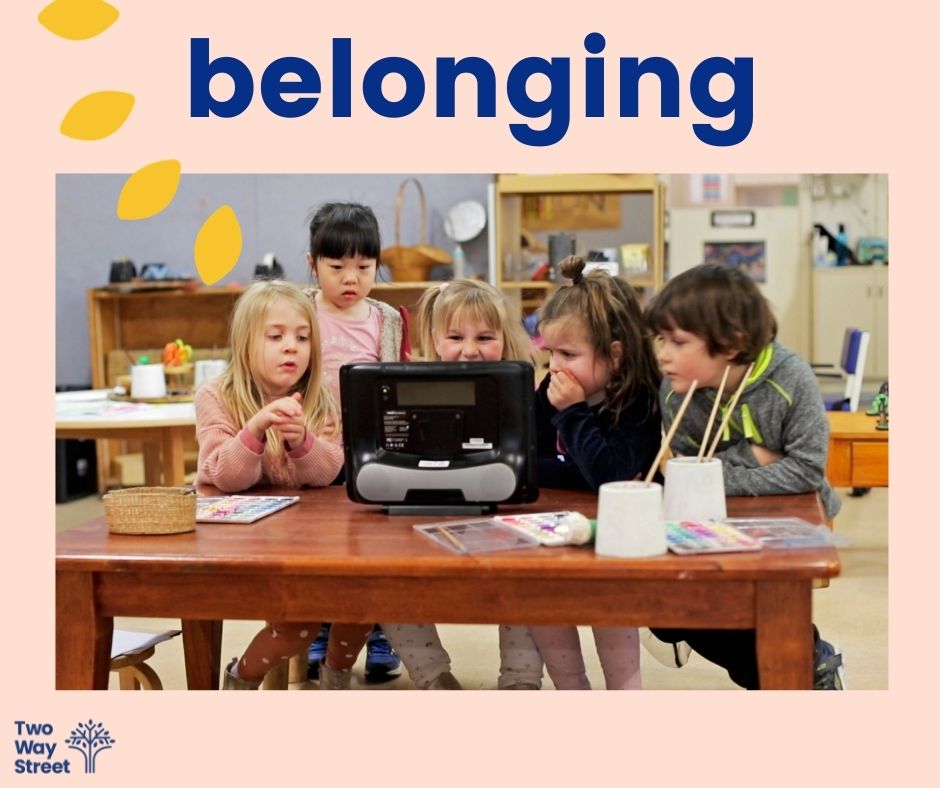AAC users15 October 2021

A sense of belonging is at the heart of inclusion. At Two Way Street, we believe this to be true. Inclusion is about more than a place, about more than just being in the same room as your peers. Inclusion is about a sense of belonging, about not only being accepted but about being valued and appreciated for who you are.
For students with complex communication needs, this also means being valued and appreciated for how they communicate, and that their voices are heard just as clearly as those of their peers. So how do we develop a sense of belonging for students with complex communication needs in inclusive schools?
To start with, we need to ensure that students with complex communication needs are able to connect with their peers and educators. When students with disability start school, there is often a lot of focus on how they will access the curriculum. But what is arguably more important is ensuring that from the outset, students with complex communication needs are able to form connections within the school community, and build and maintain relationships as they progress through their grades.
Some simple strategies to assist with building connections may include:
An important component of belonging is the sense that you are accepted and valued by your community. For students with complex communication needs, the presence of AAC within the environment sends the message that their language is important, and valued within the school community. As a speech pathologist working in schools, I find that this works best when symbolic language, perhaps in the form of an aided language display (ALD), is embedded into classroom routines and activities that already exist. This way, AAC becomes an enhancing component of existing activities, rather than an additional activity that educators have to fit into their day. Here are just some examples of how AAC can be embedded into the school community (all of these examples are from inclusive kindergartens or schools in South Australia).






Embedding AAC tools within the environment is an important starting point in developing a sense of belonging for students with complex communication needs. The next step is to support other people in the environment to use the communication tools during interactions. This should include everyone from the teachers, teacher aides, school administration staff, and perhaps most importantly, peers. When other people use a child’s communication system (or other AAC tools) while interacting with them, it implies to the student with complex communication needs that how they communicate is important, that their voice is valued, and that they belong.
Running a formal peer training session can be a useful strategy in supporting students to develop familiarity with their peer’s communication system, and building their confidence in interacting with their peer. It is important to note that peer training sessions should be developed and run in collaboration with the student with complex communication needs and their family.
Activities in peer training sessions can include:


When students feel as though they belong, they feel accepted and valued by their community. It is therefore the shared responsibility of individuals within a particular community to embrace each and every child for who they are, and to recognise their own unique strengths. For students with complex communication needs, this also means valuing how they communicate, by building a school community that understands and embraces AAC. This will allow students with complex communication needs to be who they really are; to belong, in their school communities. Because, to quote AAC user Sara Pyska, author of Inside My Outside,
“the feeling of being yourself with someone is priceless”.
To download free Aided Language Displays visit https://twowaystreet.com.au/online-learning-and-products/
For more examples of children who use AAC in inclusive settings, visit https://vimeo.com/showcase/8678812
For more information about building peer relationships for for beginning communicators in inclusive primary school settings, visit https://spaace.com.au/wp-content/uploads/2021/10/Building-Peer-Relationships-2021.pdf
